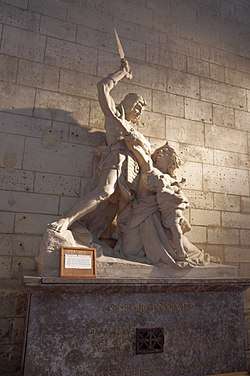Sicarius of Brantôme
Sicarius of Brantôme or Sicarius of Bethlehem (Sicaire de Brantôme, Sicaire de Bethléem) was a child saint who was venerated from the time of Charlemagne onwards as one of the victims of the Massacre of the Innocents by Herod the Great,[1][2][3][4] said to have occurred in Bethlehem at the time of the birth of Jesus. His remains are housed in the Abbey of Saint-Pierre in Brantôme, Dordogne, France.[5]
Saint Sicarius of Brantôme | |
|---|---|
Stained glass window representing St. Sicarius. Church of Sainte-Madeleine, Montagrier, Dordogne, France. | |
| Martyr | |
| Died | ~7–2 BC Bethlehem |
| Venerated in | Roman Catholic Church |
| Major shrine | Abbey church of Saint-Pierre de Brantôme |
| Feast | 2 May |
| Attributes | Depicted as an infant |
| Patronage | Invoked for general cures[1] |
Relics
Saint Helen is said to have recovered the relics from the Holy Land in 328 AD.[2] The relics were then brought to the Abbey of Saint-Pierre in Brantôme, Dordogne, by Charlemagne.[5] Saint-Pierre had been founded by Pippin I of Aquitaine.[5] Sicarius' remains are stored in a small glass-and-bronze reliquary mounted on the church wall.[6]
Authenticity
According to Wasyliw, the bones may simply be those of a child who had been named after a bishop of Laon.[1] In the 19th century, Sabine Baring-Gould was skeptical and wrote that "how the infant of a Hebrew mother acquired a Latin name has not been attempted to be explained".[7] This sentiment was echoed in 2014 by Kristan Lawson and Anneli Rufus:
The massacre happened a long time ago when Jesus, still a baby himself, hadn't yet developed the following that would turn into Christianity. (Thus, you might wonder, how did anyone have the foresight to scoop up this dead baby? Ask not, friend.)[6]
The inscription of the tomb, dedicated to an "innocent" child, may have caused the confusion and the subsequent veneration as a Holy Innocent.[1] Sicarius represents an "impulse to personify the supposedly ancient relic with names may imply a heightened sympathy for the sufferings of the infants, and perhaps for their grieving families as well".[1] Sicarius' name is odd; it means "cut-throat" or "assassin".[5][7]
St. Memorius (Mémoire) was another child martyr and purported Holy Innocent whose relics were translated during the reign of Charlemagne; they were taken to the Cathedral of St. Front in Périgueux from St. Peter's Basilica in Rome.[1]
A fountain near the monastery of Brantôme is named after Sicarius.[7]
Images
- Image from the abbey church of Saint-Pierre de Brantôme. Detail of the central part of a painted carved oak panel, depicting Charlemagne presenting the relics of St. Sicarius to the monks of the abbey.
 Sculpture representing the martyrdom of Saint Sicarius, Brantôme.
Sculpture representing the martyrdom of Saint Sicarius, Brantôme.
References
- Wasyliw, Patricia Healy (2008). Martyrdom, Murder, and Magic: Child Saints and Their Cults in Medieval Europe. 2. Peter Lang. p. 46. ISBN 0820427640.
- Craughwell, Thomas J. (2011). Saints Preserved: An Encyclopedia of Relics. Doubleday Religious Publishing Group. p. 267.
- Jean Du Puy, L'Etat de l'Eglise du Périgord depuis le christianisme (Daloy, 1629), Original from Lyon Public Library (Bibliothèque jésuite des Fontaines). Digitized Dec 20, 2010, p. 268.
- "Abbatiale Saint-Pierre de Brantôme". PÉRIGORD Dronne Belle. Retrieved March 9, 2015.
- Remensnyder, Amy Goodrich (1995). Remembering Kings Past: Monastic Foundation Legends in Medieval Southern France. Cornell University Press. pp. 164–5. ISBN 0801429544.
- Lawson, Kristan; Rufus, Anneli (2014). Weird Europe: A Guide to Bizarre, Macabre, and Just Plain Weird Sights. St. Martin's Griffin. ISBN 1466867620.
- Sabine Baring-Gould, Castles and Cave Dwellings of Europe, ReadHowYouWant.com, 2008, pp. 287–8.
External links

- Sicarius of Brantôme at Find a Grave